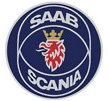Saab-Scania

Saab-Scania AB was the name chosen when truck and bus manufacturer Scania AB of Södertälje merged with car and aeroplane manufacturer Saab AB of Trollhättan on 1 September 1969,[1][2] under the Wallenberg family group of companies. The merger meant that Saab no longer had to import the British Triumph Slant-4 engine, and could instead use the engine production facilities of Scania. In 1972 they started manufacturing the 2.0 L B version. In 1977, Saab took advantage of Scania's experience with turbochargers and added one to the engine, thus creating one of the earliest turbocharged automobile engines to be produced in large numbers.
Saab-Scania consisted of following divisions:
- Aircraft (traded under the Saab AB brand) - until 1995
- Cars (traded under the Saab Automobile brand) - until 1990
- Trucks & Buses (traded under the Scania brand) - until 1995
Saab-Scania had following subsidiaries:
- AB Svenska Järnvägsverkstädernas Aeroplanavdelning (ASJA) - until 1981
- Jönköping - until 1983
- Nordarmatur - until 1983
- Parca Norrahammar - until 1983
- MJ - until 1984
- Enertech - to 1988
- Combitech - from 1982 to 1995
When the corporation was split in 1995 the name of the truck and bus division changed back to Scania AB. Saab Aircraft (Saab AB) and Saab cars were also split, with General Motors buying a major holding in Saab Automobile AB.
Products
For information on the products of this company, its predecessors and successors, see:
- Saab AB — aviation products, including aircraft
- Saab Automobile — automobiles
- Scania — trucks, buses, engines, emergency services and military vehicles
- Vabis (1891) — railway carriages, engines, automobiles and trucks before the Scania-Vabis merger, in 1911
- Maskinfabriks-aktiebolaget Scania (1900) — bicycles, engines, automobiles and trucks before the Scania-Vabis merger, in 1911
See also
- Marcus Wallenberg-hallen - Scania Museum in Södertälje, Sweden
- Swedish Air Force Museum - aircraft museum in Linköping, Sweden
References
- ↑ Berg, Jørgen Seemann (1995). King of the road i femti år: Norsk Scania AS 1945-1995 (in Norwegian). Oslo, Norway: Norsk Scania AS. p. 85. ISBN 82-993693-0-4.
- ↑ Gunston, Bill (2005). World Encyclopedia of Aircraft Manufacturers, 2nd Edition. Phoenix Mill, Gloucestershire, England, UK: Sutton Publishing Limited. p. 164. ISBN 0-7509-3981-8.
External links
- Saab Aerotech website
- Saab Automobile website
- The Saab Car Museum
- Scania corporate site
- Scania Museum at Södertälje
- Saab Group website